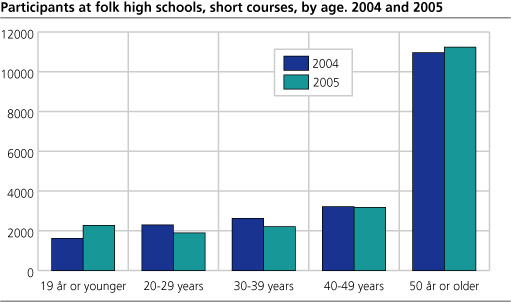Content
Published:
This is an archived release.
More youngsters attend short courses
The number of participants in short courses at Norwegian folk high schools aged 19 years or younger increased by 40 per cent last year. This age group account for 11 per cent of all participants. One out of to participants are 50 years old or more. 63 per cent of the people attending short courses are women.
There were 20 800 people attending short courses at folk high schools in 2005. This is a slight increase compared with 2004. Participants aged 19 years or younger increased from roughly 1 620 in 2004 to 2 270 in 2005, representing an increase of 40 per cent. In the age group 30-39 years old the number of participants fell by 16 per cent. As in previous years, majority of participants are 50 years old or above. 64 per cent of the participants in this age group are women, and they represents one third of the total number of people attending short courses.
Aesthetic subjects and handicraft still most popular
As in previous years, aesthetic subjects and handicraft are the most popular courses with respectively 8 050 and 4 230 participants. In the age group 19 years or younger most of the participants choose courses in organisation and management. Most of the participants in aesthetic subjects and handicraft are 50 years or older.
Fewer participants with a foreign citizenship
The number of people attending short courses with a foreign citizenship has dropped from 2 230 in 2004 to 1 630 in 2005, a decrease of 27 per cent. The two largest groups of people participating with foreign citizenship are Russian or German, with respectively 368 and 359 participants. The number of Russian participants is nearly reduced by 50 per cent, compared to 2004. Most of the foreign participants are woman.
Tables:
- Table 1 Participants at folk high schools, short courses, by age, gender and county of residence. 2001-2005
- Table 2 Foreign participants at folk high scools, short courses, by citizenship and gender. 2005
- Table 3 Participants at folk high scools, short courses, by gender, age and subject. 2005
- Table 4 Participants at folk high schools, short courses, by subject and county of school. 2005
- Table 5 Number of full-time equivalents, by gender and county of school. 2002-2005
- Table 6 Full-time equivalents, by gender and subject. 2005
Contact
-
Maja Kalcic
E-mail: maja.kalcic@ssb.no
tel.: (+47) 48 19 72 40
-
Rachel Ekren
E-mail: rachel.ekren@ssb.no
tel.: (+47) 95 83 89 67

